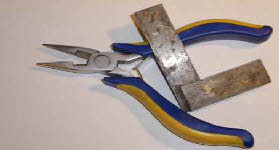


Last updated March 2021
Epilogue (I know it should be ‘Prologue’ but I wrote this bit after the main article on the next page)
I’ve been experimenting with AJ’s since 2009, and progressively improved their reliability, to the point where I don’t think I could have improved them any further. With Plumpton Green set up in the garage, I found their performance acceptable. However, since the layout was first exhibited in 2014 we have striven to improve the running reliability of the layout, and it now seems that AJ’s are ‘the weakest link’.
This rather came to a head at Scalefour North in 2017 where one or two of my fellow operators became extremely frustrated by the occasional failure of some elements of the couplings.
There seem to be a few issues which relate to the design of the couplings, and some other issues which perhaps come down to the quality of my stock or trackwork. The ‘features’ of the coupling design which seem unavoidable are:
- when pushing vehicles around even a modest (prototypical scale) curve, the couplings will disengage, which is not a problem until you need to shunt in the opposite direction. At this point, unless the whole train is on a reasonably straight section of track, the train may become divided, necessitating some manual intervention to recouple the train. This is a particular problem with locos which have a long overhang, such that the rear of the loco swings outward on a curve, disengaging the coupling.
- it is not possible to position uncoupling magnets everywhere, so quite a bit of manual uncoupling is required. There is a technique to this which some of my fellow exhibition operators struggled with - it sometimes seemed to take longer to uncouple two AJ fitted vehicles than to couple with 3-links.
- when coupling two vehicles together, a small force is required to overcome the resistance of the coupling. When shunting to couple to one wagon in a siding of uncoupled wagons, there is the possibility that instead of coupling to the wagon in question, this wagon may simply be propelled into the one behind - and then require manual uncoupling.
The end result of the above is that AJ’s didn’t entirely solve the ‘big hand from the sky’ problem.
One of the most frustrating issues was the occasional uncoupling of trains in motion - perhaps only one or two occurrences during a full day’s operation, but still too many. There seem to be several reasons for this:
- a very slight change in level (for example from a cassette onto the layout).
- a loco faltering very briefly, causing the vehicles to bunch up and take the tension off the couplings
- no doubt some inaccuracies in my manufacture or adjustment of the couplings
- all of these combined together
- the complete failure of the coupling - breaking at the 180deg bend for example
There is also of course the issue of appearance. AJ’s are undoubtedly the best of the bunch in terms of their appearance, and near invisibility from a reasonable viewing distance, but the lack of scale couplings is very noticeable in my view.
So, taking note of the above, and of my fellow operators very strong preference for 3-link couplings, I have removed all the AJ’s and reinstated 3-link or screw-link, as appropriate. A few of my loose goods wagons had been fitted with Exactocale hooks, which look very nice, but are just a little too close to the prototype (especially their thickness) to be easy to couple up. I’ve replaced all these with thinner brass near-scale hooks. I’ve also replaced all the bottom links with Brassmasters’ copper links. These are over-scale, but can be easily reduced to prototypical size. Their chief benefit is that the thinner wire makes it easier place the final link on the hook.
My screw couplings are a mixture of Branchlines cast brass (unfortunately no longer available) and Masokits.
AJ’s undoubtedly work, or they wouldn’t have survived for over 50 years. So for those interested in experimenting, the article starting on the next page describes my experiences, written when I was a bit more optimistic about their use.
Epilogue (I know it should be ‘Prologue’ but I wrote this bit after the main article on the next page)
I’ve been experimenting with AJ’s since 2009, and progressively improved their reliability, to the point where I don’t think I could have improved them any further. With Plumpton Green set up in the garage, I found their performance acceptable. However, since the layout was first exhibited in 2014 we have striven to improve the running reliability of the layout, and it now seems that AJ’s are ‘the weakest link’.
This rather came to a head at Scalefour North in 2017 where one or two of my fellow operators became extremely frustrated by the occasional failure of some elements of the couplings.
There seem to be a few issues which relate to the design of the couplings, and some other issues which perhaps come down to the quality of my stock or trackwork. The ‘features’ of the coupling design which seem unavoidable are:
-
The end result of the above is that AJ’s didn’t entirely solve the ‘big hand from the sky’ problem.
One of the most frustrating issues was the occasional uncoupling of trains in motion -
There is also of course the issue of appearance. AJ’s are undoubtedly the best of the bunch in terms of their appearance, and near invisibility from a reasonable viewing distance, but the lack of scale couplings is very noticeable in my view.
So, taking note of the above, and of my fellow operators very strong preference for 3-
My screw couplings are a mixture of Branchlines cast brass (unfortunately no longer available) and Masokits.
AJ’s undoubtedly work, or they wouldn’t have survived for over 50 years. So for those interested in experimenting, the article starting on the next page describes my experiences, written when I was a bit more optimistic about their use.